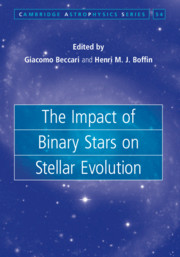Book contents
- Frontmatter
- Contents
- List of Contributors
- Foreword
- Introduction
- 1 The Zoo of Binary Stars
- 2 Statistics of Binary and Multiple Stars
- 3 Gaia and LSST: Their Importance in Binary Star Research
- 4 Population Synthesis of Binary Stars
- 5 Low- and Intermediate-Mass Star Evolution: Open Problems
- 6 The Symbiotic Stars
- 7 Binary Post-AGB Stars as Tracers of Stellar Evolution
- 8 The Importance of Binarity in the Formation and Evolution of Planetary Nebulae
- 9 Massive Star Evolution: Binaries as Two Single Stars
- 10 Binarity at High Masses
- 11 Luminous Blue Variables: Their Formation and Instability in the Context of Binary Interactions
- 12 Type Ia Supernovae: Where Are They Coming From and Where Will They Lead Us?
- 13 Binary Interactions and Gamma-Ray Bursts
- 14 Binaries as Sources of Gravitational Waves
- 15 The Impact of Binaries on the Stellar Initial Mass Function
- 16 The Formation of Binary Stars: Insights from Theory and Observation
- 17 The Maxwell’s Demon of Star Clusters
- 18 Alternative Stellar Evolution Pathways
- 19 Clocks and Scales: Playing with the Physics of Blue Stragglers
- 20 Binaries at Very Low Metallicity
- 21 Population and Spectral Synthesis: It Doesn’t Work without Binaries
- Index
4 - Population Synthesis of Binary Stars
Published online by Cambridge University Press: 05 April 2019
- Frontmatter
- Contents
- List of Contributors
- Foreword
- Introduction
- 1 The Zoo of Binary Stars
- 2 Statistics of Binary and Multiple Stars
- 3 Gaia and LSST: Their Importance in Binary Star Research
- 4 Population Synthesis of Binary Stars
- 5 Low- and Intermediate-Mass Star Evolution: Open Problems
- 6 The Symbiotic Stars
- 7 Binary Post-AGB Stars as Tracers of Stellar Evolution
- 8 The Importance of Binarity in the Formation and Evolution of Planetary Nebulae
- 9 Massive Star Evolution: Binaries as Two Single Stars
- 10 Binarity at High Masses
- 11 Luminous Blue Variables: Their Formation and Instability in the Context of Binary Interactions
- 12 Type Ia Supernovae: Where Are They Coming From and Where Will They Lead Us?
- 13 Binary Interactions and Gamma-Ray Bursts
- 14 Binaries as Sources of Gravitational Waves
- 15 The Impact of Binaries on the Stellar Initial Mass Function
- 16 The Formation of Binary Stars: Insights from Theory and Observation
- 17 The Maxwell’s Demon of Star Clusters
- 18 Alternative Stellar Evolution Pathways
- 19 Clocks and Scales: Playing with the Physics of Blue Stragglers
- 20 Binaries at Very Low Metallicity
- 21 Population and Spectral Synthesis: It Doesn’t Work without Binaries
- Index
Summary
Many aspects of the evolution of stars, and in particular the evolution of binary stars, are beyond our ability to model them in detail. Instead, we rely on observations to guide our often phenomenological models and pin down uncertain model parameters. To do this statistically requires population synthesis. Populations of stars modelled on computers are compared to populations of stars observed with our best telescopes. The closest match between observations and models provides insight into unknown model parameters and hence the underlying astrophysics. This chapter reviews the impact that modern big-data surveys will have on population synthesis, the large parameter space problem that is rife for the application of modern data science algorithms and some examples of how population synthesis is relevant to modern astrophysics.
- Type
- Chapter
- Information
- The Impact of Binary Stars on Stellar Evolution , pp. 45 - 61Publisher: Cambridge University PressPrint publication year: 2019

